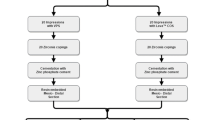Abstract
This in vitro study assessed the marginal gap and marginal microleakage in zirconia copings fabricated using two computer aided techniques- CAD milling and Copy milling and cemented to respective tooth preparations using two resin bonding systems, light cure and self-cure resin bonding systems. 32 extracted premolars were prepared to receive zirconia copings fabricated using CAD/CAM and Copy milling techniques. Once the copings were fabricated, the samples were evaluated for marginal fit prior to cementation through microscopic observation. Evaluation of marginal gap was done again after cementation, in order to incorporate the influence of the resin bonding system on the marginal microgap. The specimens were evaluated under the stereomicroscope for micro-leakage using commercial software. A comparative statistical analysis was done following data collection using Mann–Whitney U test, Wilcoxon test and chi-square test. The data collected regarding marginal gap was well within 120 µ, which is in accordance with previous studies. However, Copy milled specimens showed statistically lesser marginal gap when compared to CAD milled specimens. While comparing microleakage, it was observed that the microleakage in Copy milled specimens bonded with light cure resin bonded cement was statistically lesser than that of specimens cemented with chemical cure resin cement.(P = 0.003). This in vitro study concluded that Copy milling technique fabricated zirconia restorations with lesser marginal gap and microleakage score in comparison to CAD milled samples. Light cure resin bonding system also proved to be more effective option compared to self cure resin bonding systems. However, the limitations of this study should be taken into concern and further research should be aimed at a larger sample size to validate the results.






Similar content being viewed by others
References
Contrepois M, Soenen A, Bartela M, Laviole O (2013) Marginal adaptation of ceramic crowns: a systematic review. J Prosthet Dent 110(6):447–454
Hamza TA, Ezzat HA, El-Hossary MM, Katamish HA, Shokry TE, Rosensteil SF (2013) Accuracy of ceramic restorations made with two CAD/CAM systems. J Prosthet Dent 109:83–87
Yuksel E, Zaimoglu A (2011) Influence of marginal fit and cement types on microleakage of all- ceramic crown systems. Braz Oral Res 25(3):261–266
Martinez-Ruz F, Suarez MJ, Rivera B, Pradies G (2011) Evaluation of the absolute marginal discrepancy of zirconia based ceramic copings. J Prosthet Dent 105:108–114
Albert FE, El-Mowafy OM (2004) Marginal adaptation and microleakage of Procera All Ceram crowns with four cements. Int J Prosthodont 17:529–535
Gu XH, Kern M (2003) Marginal discrepancies and leakage of all ceramic crowns: Influence of luting agents and ageing conditions. Int J Prosthodont 16:109–116
Helvey GA (2007) Zirconia and computer aided design/CAM dentistry. Funct Aesthet Restor Dent 1(3):28–39
Baldissara P, Llukacej A, Ciocca L, Valandro FL, Scotti R (2010) Translucency of zirconia copings made with different CAD/CAM systems. J Prosthet Dent 104:6–12
Cekic-Nagas I, Eglimez F, Ergun G, Kaya BM (2013) Light transmittance of zirconia as a function of thickness and microhardness of resin cements under different thicknesses of zirconia. Med Oral Patol Oral Cir Bucal 18(2):e212–e218
Person A, Anderson M, Oden A, Sandborgh G (2006) A three dimensional evaluation of a laser scanner and a touch probe scanner. J Prosthet Dent 95:194–200
Jeong S, Kang DW (2001) Wolf C, Evaluation of marginal fidelity of Copy milled and CAD/CAM all ceramic crowns. J Korean Acad Prosthodont 39(3):243–249
Raigrodski AJ (2003) Clinical and Laboratory considerations for the use of CAD/CAM Y-TZP based restorations. Pract Proceed Aesthet Dent 15:469–476
Doyle MG et al (1990) The effect of tooth preparation design on the breaking strength of Dicor crowns: 2. Int J Prosthodont 3:241–248
Holmes JR, Bayne SC, Holland GA, Sulik WD (1989) Considerations in measurement of marginal fit. J Prosthet Dent 62:405–408
McLean JW, von Fraunhofer JA (1971) The estimation of cement film thickness by an in vivo technique. Br Dent J 131:107–111
Baldissara et al (1998) Comparitive study of marginal microleakage of 6 cements in provisional crowns. J Prosthet Dent 80:417–422
Rinke S, Huls A, Jahn L (1995) Marginal accuracy and fracture strength of conventional and copy milled all-ceramic crowns. Int J Prosthodont 8:303–310
Palacios Johnson, Philips Raigrodski (2006) Retention of Zirconium oxide ceramic crowns with three types of cement. JPD 96:104–114
Mirza RB, Tan KCB, Nicholls JI (2010) Evaluation of marginal fit of a zirconia ceramic computer- aided machined (CAM) crown system. J Prosthet Dent 104(4):216–227
Badrawy El (1995) Chemical versus dual curing of resin inlay cements. J Prosthet Dent 73:15–24
Author information
Authors and Affiliations
Corresponding author
Rights and permissions
About this article
Cite this article
Shetty, M., Rajalakshmi, S. & Krishna Prasad, D. Comparison of Marginal Gap and Microleakage in Copy-Milled and Cad-Milled Zirconia Copings Bonded Using Light Cure and Chemical Cure Resin Bonding Systems. J Indian Prosthodont Soc 14 (Suppl 1), 37–45 (2014). https://doi.org/10.1007/s13191-014-0359-x
Received:
Accepted:
Published:
Issue Date:
DOI: https://doi.org/10.1007/s13191-014-0359-x




